Explore the ultimate list of Trees that start with S, Discover a variety of stunning species, their unique characteristics and care tips to enhance your garden.
Trees are an essential part of our natural world, providing shade, beauty and countless ecosystem services. In this comprehensive guide, we’ll explore a fascinating group of trees – those whose names begin with the letter S. From towering giants to delicate ornamentals, these trees offer a diverse range of characteristics and uses. Let’s dive into the world of S-trees and discover their unique qualities.
1. Sycamore: The Majestic Shade Provider
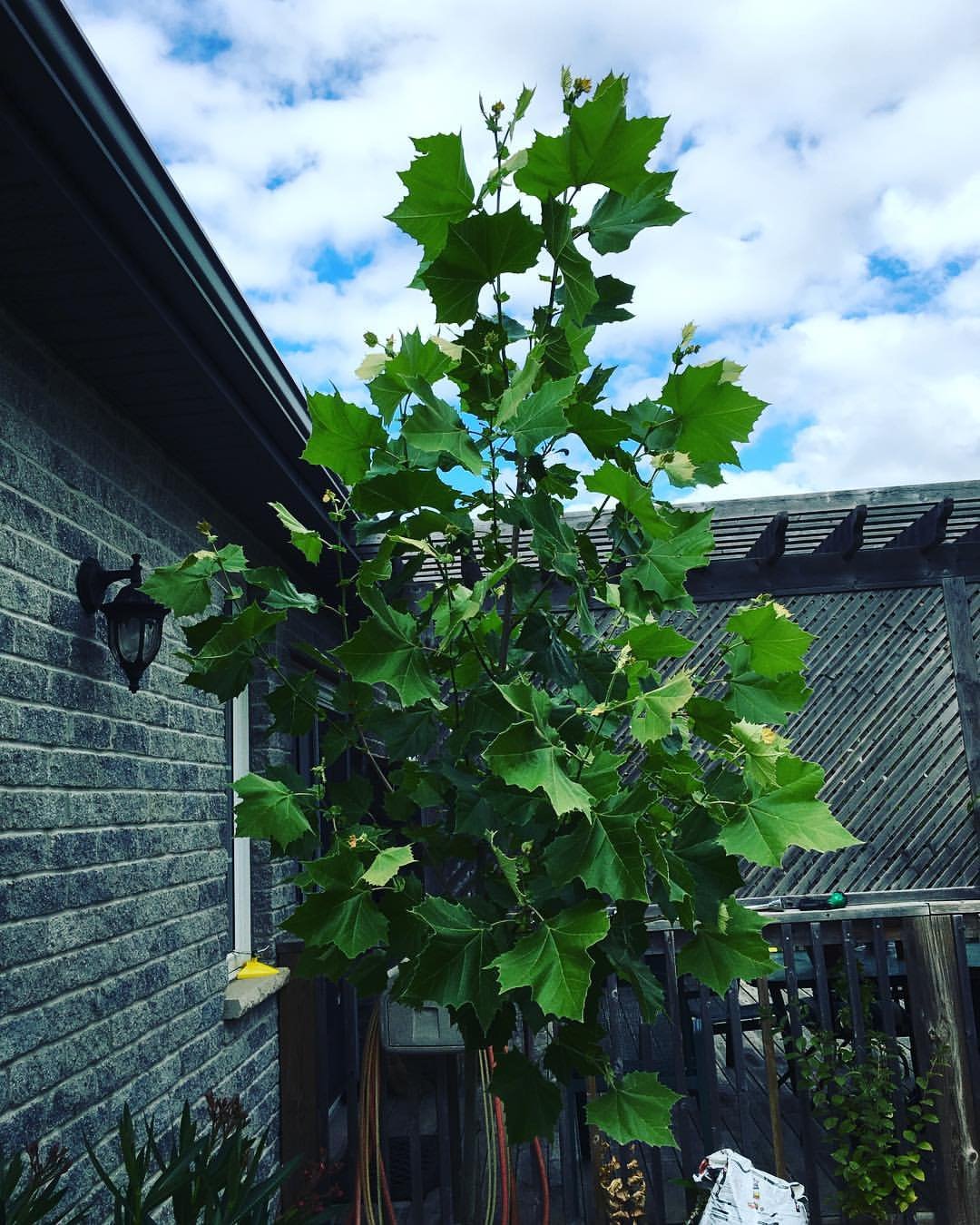
Here’s a short information chart about the Sycamore tree:
| Aspect | Information |
|---|---|
| Botanical Name | Platanus occidentalis (American Sycamore) |
| Platanus orientalis (Oriental Sycamore) | |
| Common Name | Sycamore |
| Plant Type | Deciduous tree |
| Zones | Typically zones 4-9 |
| Sun Exposure | Full sun to partial shade |
| Soil Type | Moist, well-drained soil |
| Watering | Regular; drought tolerant once established |
| Growth Habit | Large, spreading canopy |
| Height/Spread | 60-100 feet tall, 40-70 feet wide |
| Special Features | Exfoliating bark, large maple-like leaves |
The sycamore tree is a well-known and beloved species in many parts of the world. With its distinctive mottled bark and large, lobed leaves, it’s a striking presence in parks, streets and forests. Sycamores can grow to impressive heights, often reaching over 100 feet tall.
Key features of sycamores:
- Fast-growing and long-lived
- Excellent shade trees
- Tolerant of urban conditions
- Important for wildlife, providing food and shelter
Sycamores are adaptable trees, thriving in various soil types and climates. Their resilience makes them popular choices for urban landscaping. However, they do require ample space due to their size and extensive root systems. For more information on sycamore trees, check out this resource from the University of Kentucky.
2. Spruce: The Evergreen Icon
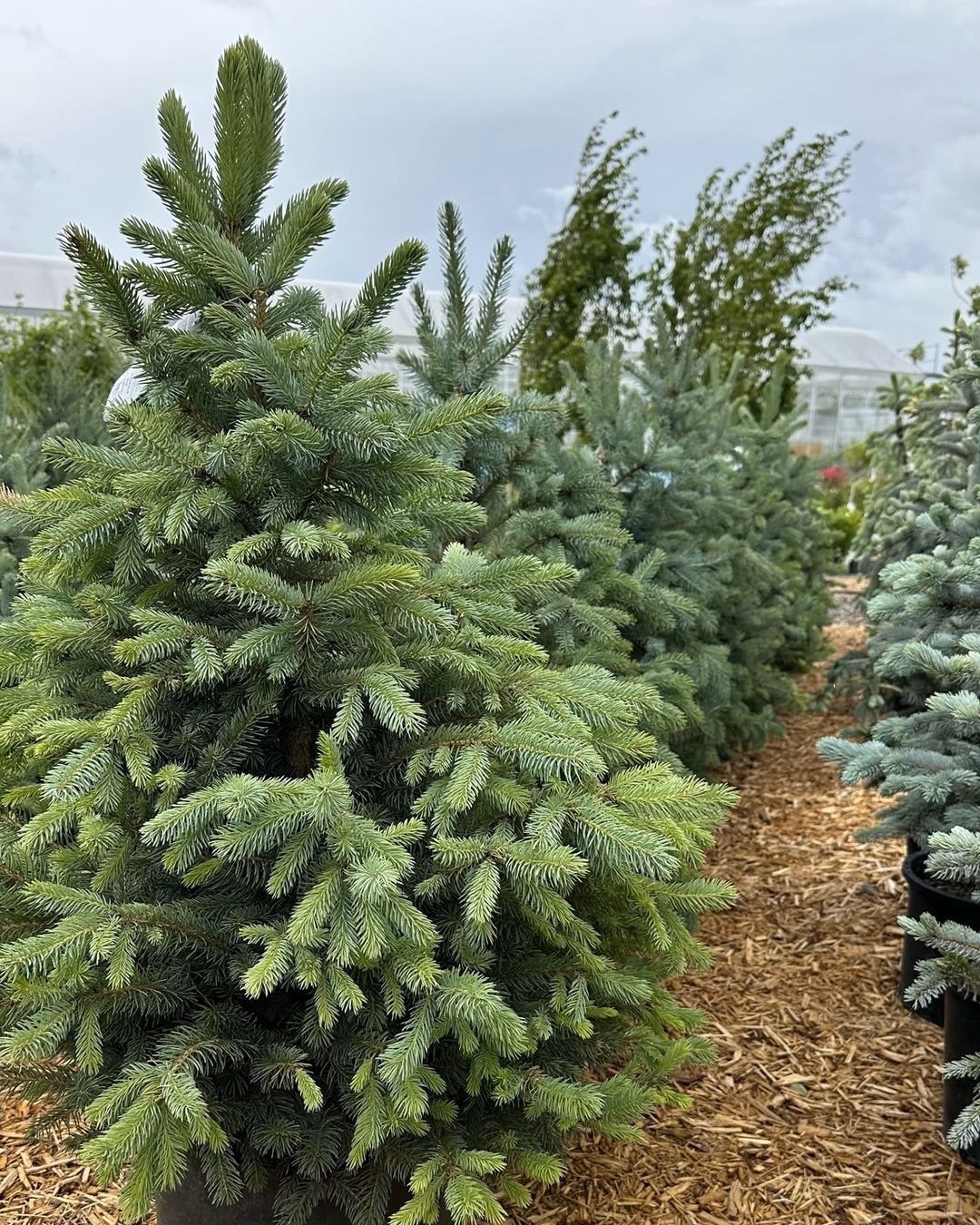
Here’s a concise information chart about Spruce trees:
| Aspect | Information |
|---|---|
| Botanical Name | Picea spp. (various species) |
| Common Name | Spruce |
| Plant Type | Evergreen coniferous tree |
| Zones | Depending on species, typically zones 2-7 |
| Sun Exposure | Full sun |
| Soil Type | Well-drained, acidic soil |
| Watering | Regular, especially when young |
| Growth Habit | Pyramid-shaped, dense foliage |
| Height/Spread | Varies widely by species, up to 60-200+ feet tall |
| Special Features | Distinctive cones, often used as Christmas trees |
Spruce trees are coniferous evergreens known for their distinctive pyramidal shape and needle-like leaves. These trees are staples of northern forests and popular choices for Christmas trees. There are about 35 species of spruce, each with its own unique characteristics.
Common spruce species include:
- Norway spruce
- Blue spruce
- White spruce
- Black spruce
Spruces play crucial roles in their ecosystems, providing year-round shelter for wildlife and stabilizing soil in mountainous regions. They’re also economically important, used for timber, paper production and as ornamental trees in landscaping. Learn more about spruce trees from the University of Maine.
3. Sugar Maple: The Sweet Symbol of Autumn

Here’s a concise information chart about the Sugar Maple tree:
| Aspect | Information |
|---|---|
| Botanical Name | Acer saccharum |
| Common Name | Sugar Maple |
| Plant Type | Deciduous tree |
| Zones | Typically zones 3-8 |
| Sun Exposure | Full sun to partial shade |
| Soil Type | Moist, well-drained soil |
| Watering | Regular; prefers moderate moisture |
| Growth Habit | Oval to rounded crown |
| Height/Spread | 60-75 feet tall, 40-50 feet wide |
| Special Features | Brilliant fall foliage, sap used for maple syrup |
The sugar maple is a tree beloved for its stunning fall foliage and its role in producing maple syrup. Native to North America, these trees are iconic symbols of autumn, with leaves that turn brilliant shades of red, orange and gold.
Key characteristics of sugar maples:
- Slow-growing but long-lived
- Excellent shade trees
- Valuable hardwood for furniture and flooring
- Source of maple syrup
Sugar maples prefer well-drained, slightly acidic soils and are sensitive to urban pollution. They’re best suited for large yards, parks and natural areas where they have room to grow and thrive. For in-depth information on sugar maples, visit the University of Vermont Extension.
4. Sequoia: The Giant of the Forest
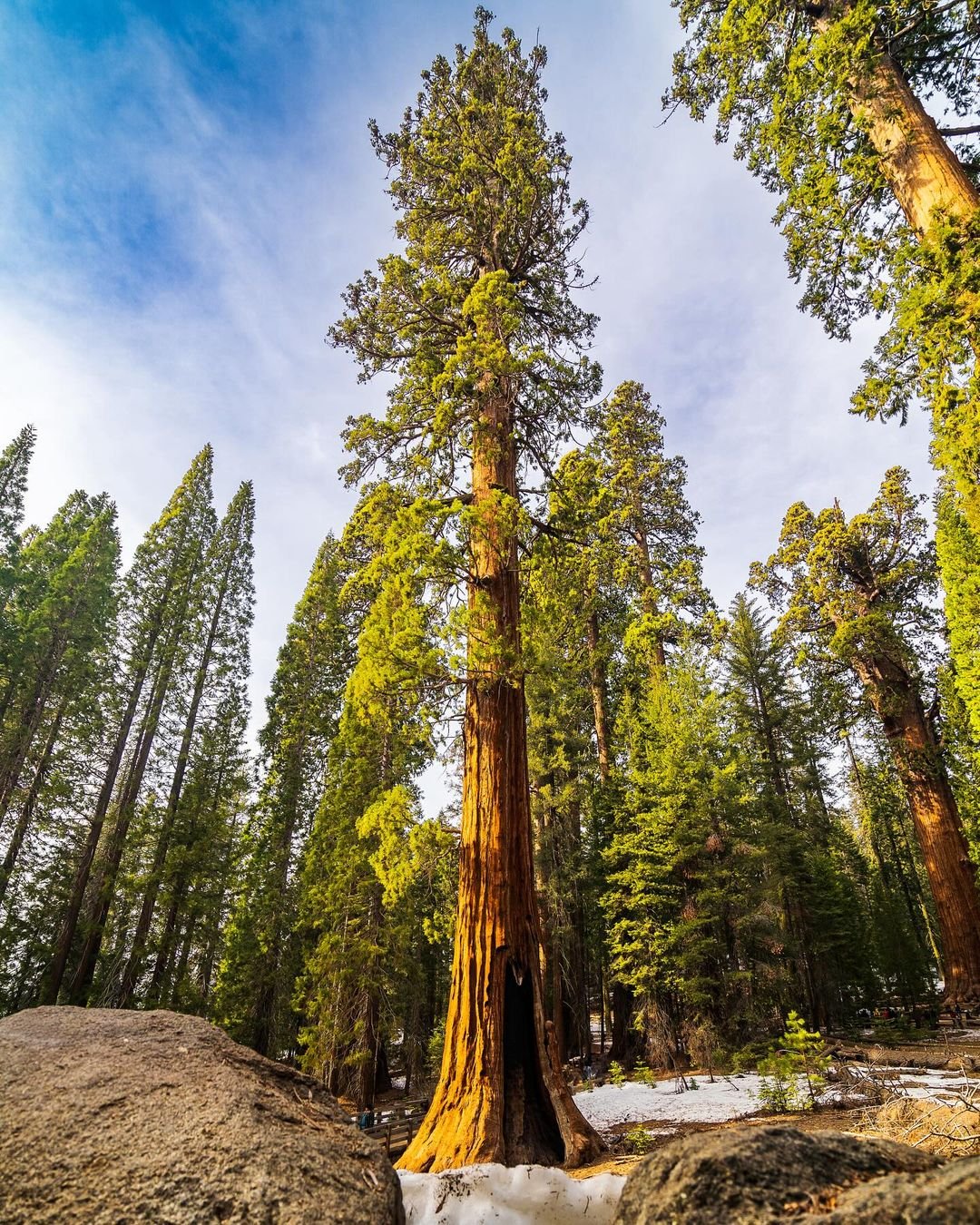
Here’s a short information chart about Sequoia trees:
| Aspect | Information |
|---|---|
| Botanical Name | Sequoia sempervirens (Coast Redwood) |
| Sequoiadendron giganteum (Giant Sequoia) | |
| Common Name | Sequoia |
| Plant Type | Evergreen coniferous tree |
| Zones | Typically zones 6-9 for Coast Redwood |
| Zones 6-8 for Giant Sequoia | |
| Sun Exposure | Full sun to partial shade |
| Soil Type | Well-drained, deep soil |
| Watering | Regular, especially when young |
| Growth Habit | Tall, straight trunk with narrow, conical crown (Coast Redwood) |
| Massive trunk with spreading branches (Giant Sequoia) | |
| Height/Spread | Coast Redwood: 200-300 feet tall, 20-30 feet wide |
| Giant Sequoia: 160-280 feet tall, 20-40 feet wide | |
| Special Features | Largest tree species by volume (Giant Sequoia), coastal habitat (Coast Redwood) |
Sequoia trees, also known as redwoods, are among the largest and oldest living organisms on Earth. These awe-inspiring giants can live for thousands of years and reach heights of over 300 feet. There are two main types of sequoias: the coast redwood and the giant sequoia.
Fascinating facts about sequoias:
- They have thick, fire-resistant bark
- Their root systems are relatively shallow but wide-spreading
- They play a crucial role in carbon sequestration
- Sequoia forests create unique ecosystems
Sequoias are native to the western coast of North America, thriving in the cool, humid climate of California’s coastal regions and the Sierra Nevada mountains. These trees face challenges from climate change and habitat loss, making conservation efforts crucial. Learn more about sequoias from the National Park Service.
5. Silver Birch: The Graceful Beauty
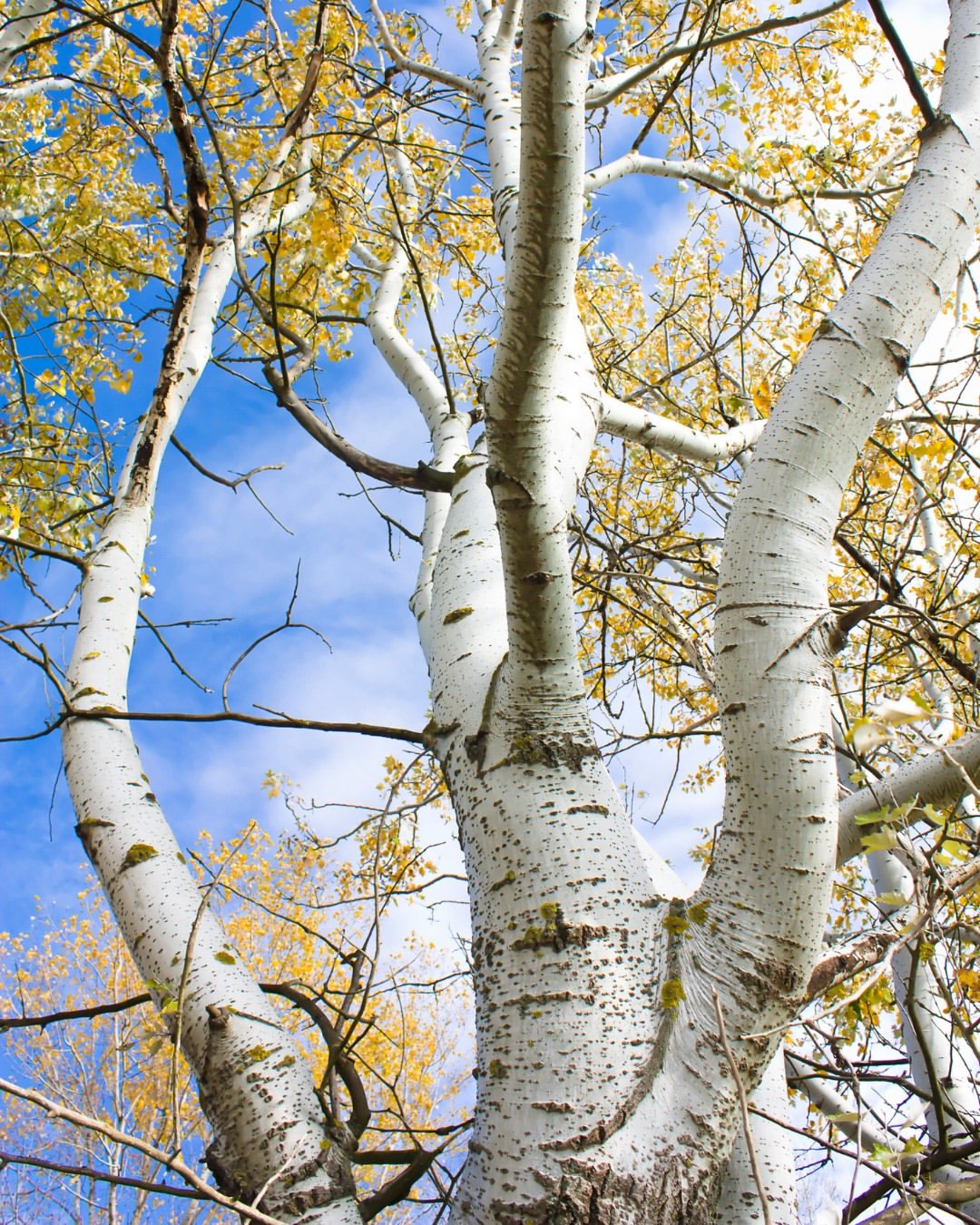
Here’s a concise information chart about the Silver Birch tree:
| Aspect | Information |
|---|---|
| Botanical Name | Betula pendula |
| Common Name | Silver Birch |
| Plant Type | Deciduous tree |
| Zones | Typically zones 3-6 |
| Sun Exposure | Full sun to partial shade |
| Soil Type | Well-drained, acidic to neutral soil |
| Watering | Regular; prefers moderate moisture |
| Growth Habit | Pyramidal when young, becoming more irregular with age |
| Height/Spread | 40-60 feet tall, 25-35 feet wide |
| Special Features | White bark with black fissures, delicate pendulous branches |
The silver birch is a slender, elegant tree known for its distinctive white bark and delicate, diamond-shaped leaves. Native to Europe and parts of Asia, it’s a popular ornamental tree that adds a touch of grace to any landscape.
Key features of silver birches:
- Fast-growing but relatively short-lived
- Tolerant of poor soils
- Important for wildlife, particularly birds and insects
- Used in traditional medicine and crafts
Silver birches prefer cool climates and do best in full sun or partial shade. They’re often used in group plantings to create a striking visual effect in gardens and parks. For more on silver birches, visit the Royal Horticultural Society.
6. Sourwood: The Bee’s Favorite
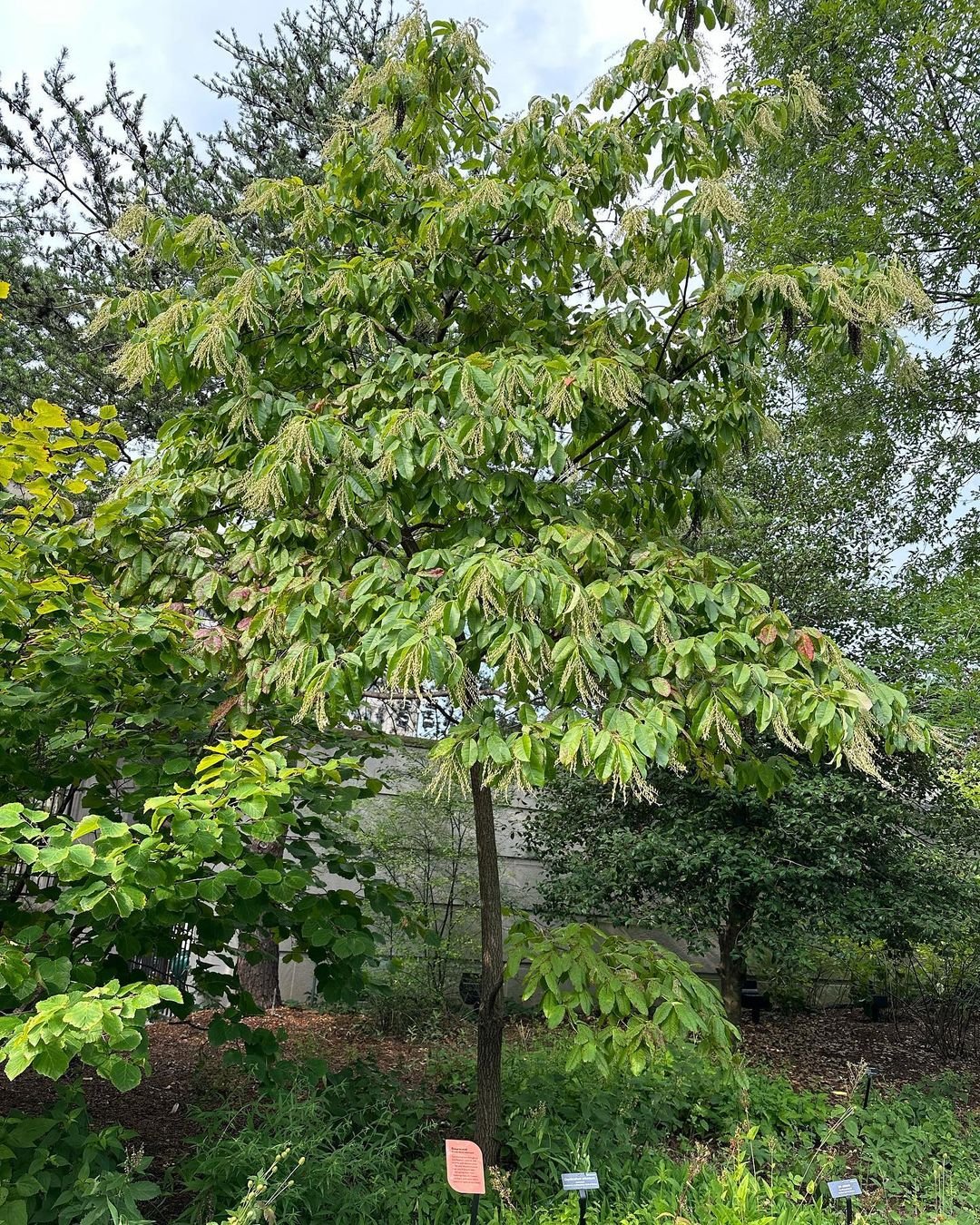
Here’s a short information chart about the Sourwood tree:
| Aspect | Information |
|---|---|
| Botanical Name | Oxydendrum arboreum |
| Common Name | Sourwood |
| Plant Type | Deciduous tree |
| Zones | Typically zones 5-9 |
| Sun Exposure | Full sun to partial shade |
| Soil Type | Moist, well-drained acidic soil |
| Watering | Regular; prefers moderate moisture |
| Growth Habit | Narrow and upright |
| Height/Spread | 25-40 feet tall, 15-25 feet wide |
| Special Features | Fragrant white flowers in summer, brilliant red fall foliage |
The sourwood tree, also known as the sorrel tree, is a medium-sized species native to eastern North America. It’s prized for its beautiful summer flowers and striking fall foliage.
Key characteristics of sourwood:
- Long, drooping clusters of white flowers
- Leaves turn bright red in autumn
- Important nectar source for honeybees
- Slow-growing but long-lived
Sourwood trees prefer acidic, well-drained soils and full sun to partial shade. They’re excellent choices for landscaping, providing year-round interest with their flowers, foliage and distinctive bark. For more information on sourwood trees, check out this resource from North Carolina State University.
7. Swamp White Oak: The Wetland Wonder
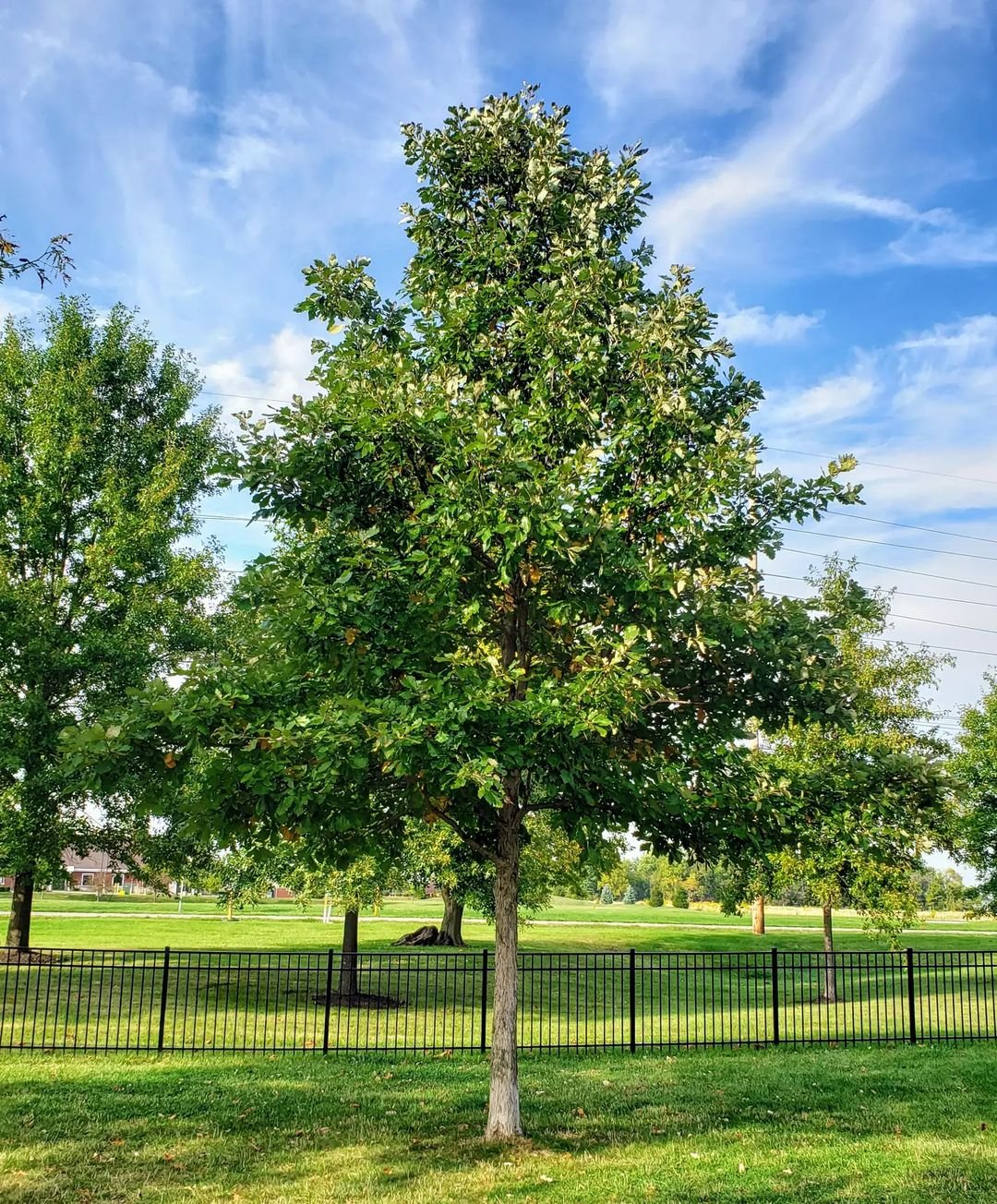
Here’s a concise information chart about the Swamp White Oak:
| Aspect | Information |
|---|---|
| Botanical Name | Quercus bicolor |
| Common Name | Swamp White Oak |
| Plant Type | Deciduous tree |
| Zones | Typically zones 4-8 |
| Sun Exposure | Full sun to partial shade |
| Soil Type | Moist to wet, well-drained soil |
| Watering | Regular; tolerant of wet conditions |
| Growth Habit | Broadly rounded crown |
| Height/Spread | 50-60 feet tall, 40-50 feet wide |
| Special Features | Deeply lobed leaves, yellow to red fall color, acorns attract wildlife |
The swamp white oak is a large deciduous tree native to eastern and central North America. As its name suggests, it’s well-adapted to wet conditions, making it a valuable species for wetland restoration and landscaping in damp areas.
Notable features of swamp white oaks:
- Tolerant of wet soils and occasional flooding
- Long-lived and relatively fast-growing for an oak
- Provides important habitat and food for wildlife
- Valuable timber tree
Swamp white oaks have distinctive leaves with wavy, rounded lobes and a whitish underside. They’re excellent shade trees and can tolerate urban conditions better than many other oak species. Learn more about swamp white oaks from the University of Kentucky.
8. Serviceberry: The Four-Season Beauty
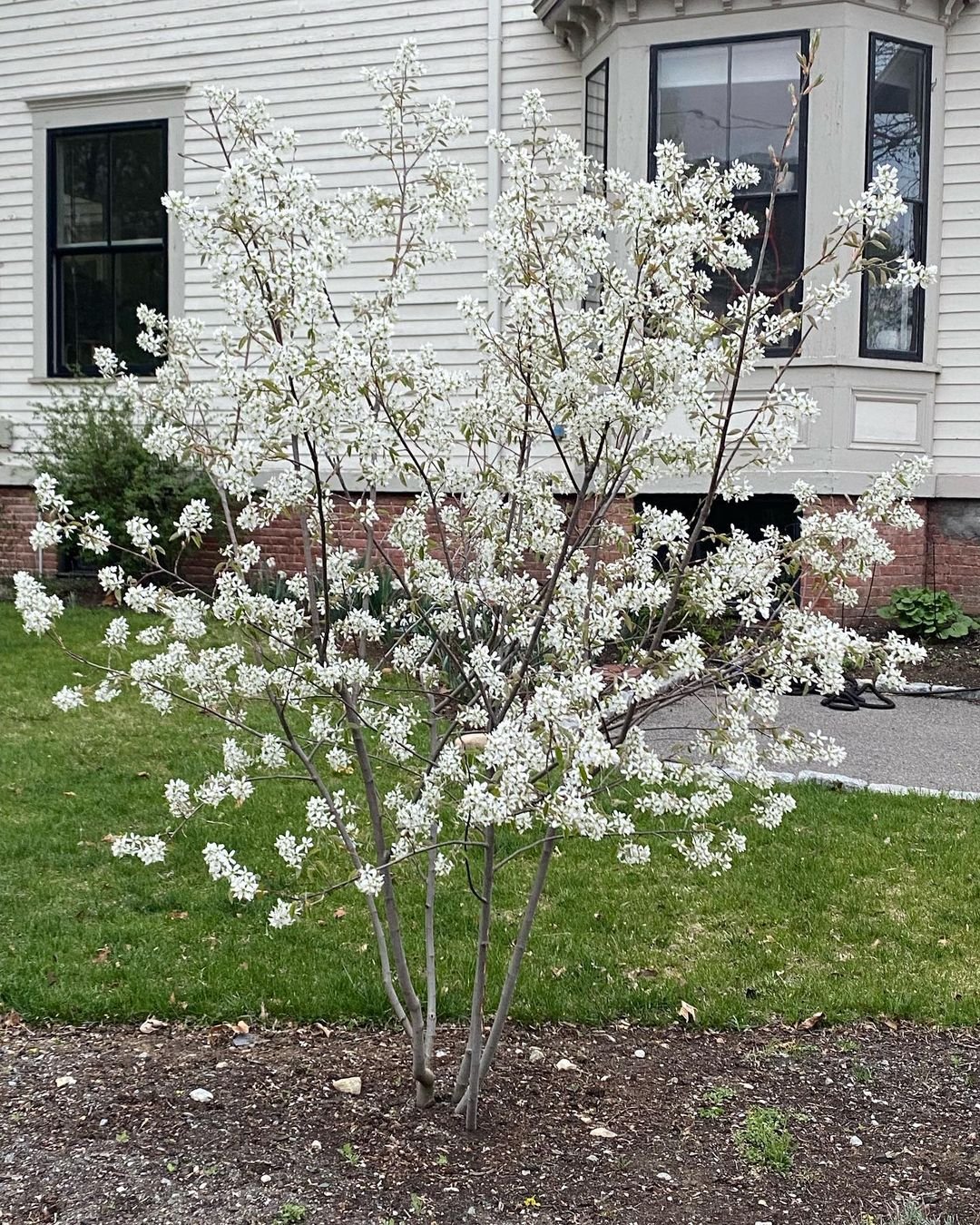
Here’s a concise information chart about the Serviceberry tree (Amelanchier spp.):
| Aspect | Information |
|---|---|
| Botanical Name | Amelanchier spp. |
| Common Name | Serviceberry, Juneberry, Shadbush |
| Plant Type | Deciduous shrub or small tree |
| Zones | Typically zones 4-9 |
| Sun Exposure | Full sun to partial shade |
| Soil Type | Well-drained, moist soil |
| Watering | Regular; prefers moderate moisture |
| Growth Habit | Multi-stemmed shrub or small tree |
| Height/Spread | 15-25 feet tall and wide (varies by species) |
| Special Features | Delicate white flowers in early spring, edible berries, vibrant fall foliage |
Serviceberry trees, also known as Juneberry or Shadbush, are small, multi-stemmed trees or large shrubs native to North America. They’re prized for their year-round ornamental value and edible berries.
Key aspects of serviceberries:
- Early spring flowers
- Edible berries in summer
- Brilliant fall foliage
- Attractive bark visible in winter
Serviceberries are adaptable trees that can thrive in a variety of soil types and light conditions. They’re excellent choices for native plant gardens and attract a wide variety of wildlife. For more on serviceberries, visit the University of Minnesota Extension.
9. Sweet Gum: The Spiky Ball Producer
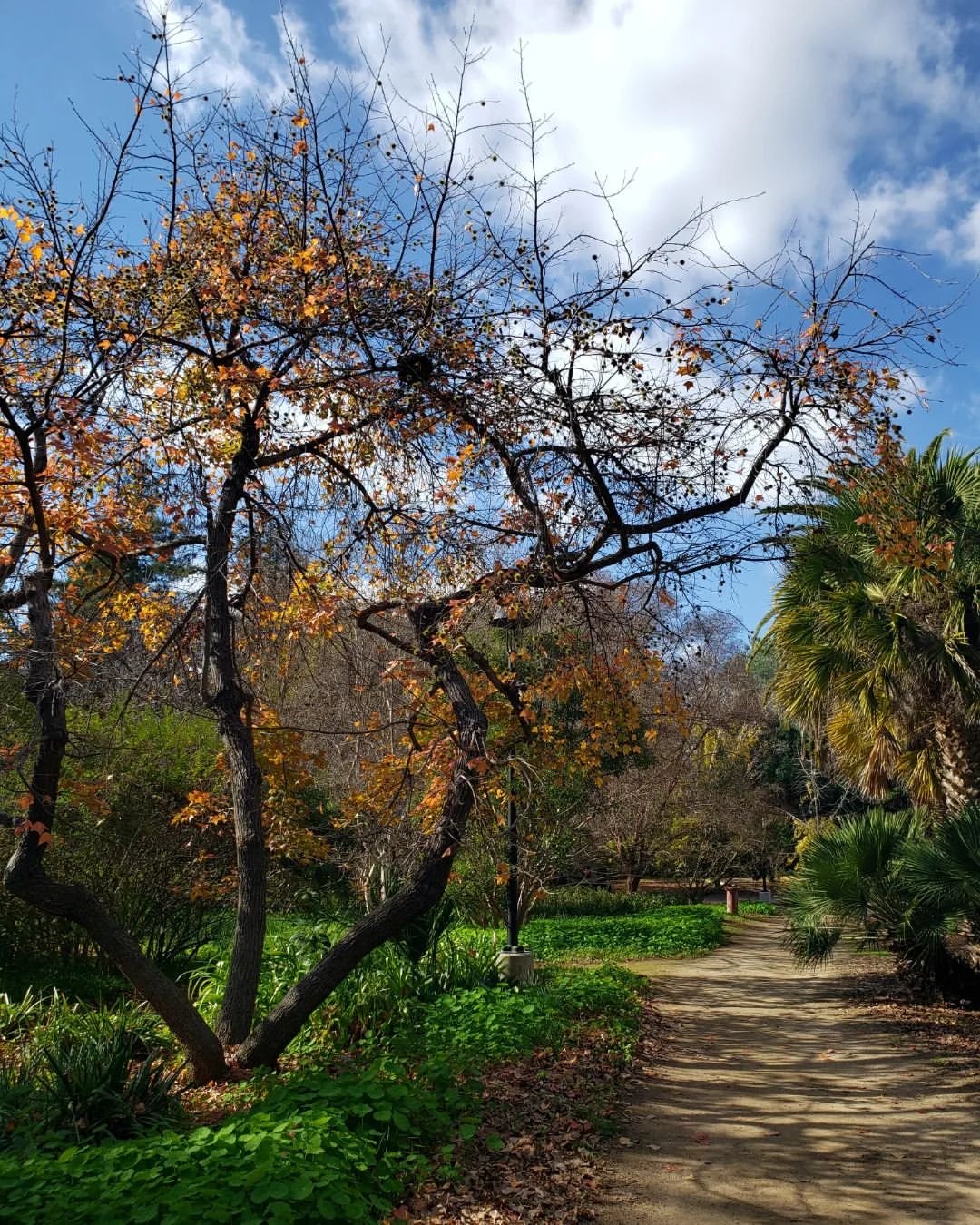
Here’s a concise information chart about the Sweet Gum tree (Liquidambar styraciflua):
| Aspect | Information |
|---|---|
| Botanical Name | Liquidambar styraciflua |
| Common Name | Sweet Gum |
| Plant Type | Deciduous tree |
| Zones | Typically zones 5-9 |
| Sun Exposure | Full sun to partial shade |
| Soil Type | Moist, well-drained soil |
| Watering | Regular; prefers moderate moisture |
| Growth Habit | Pyramidal when young, becoming more rounded with age |
| Height/Spread | 60-75 feet tall, 40-50 feet wide |
| Special Features | Star-shaped leaves, spiky fruit balls (gumballs), brilliant fall foliage |
The sweet gum tree is a large deciduous species native to the southeastern United States. It’s known for its star-shaped leaves and distinctive spiky seed balls.
Interesting facts about sweet gums:
- Brilliant fall colors ranging from yellow to deep purple
- Spiky seed balls can be a nuisance in landscaped areas
- Wood is used for furniture and veneer
- Tolerant of wet soils and urban conditions
Sweet gums are fast-growing trees that can reach heights of 60-75 feet. They’re valuable for reforestation efforts and urban landscaping, but their seed balls can make them less desirable for some homeowners. Learn more about sweet gum trees from Clemson University.
10. Sumac: The Colorful Colonizer
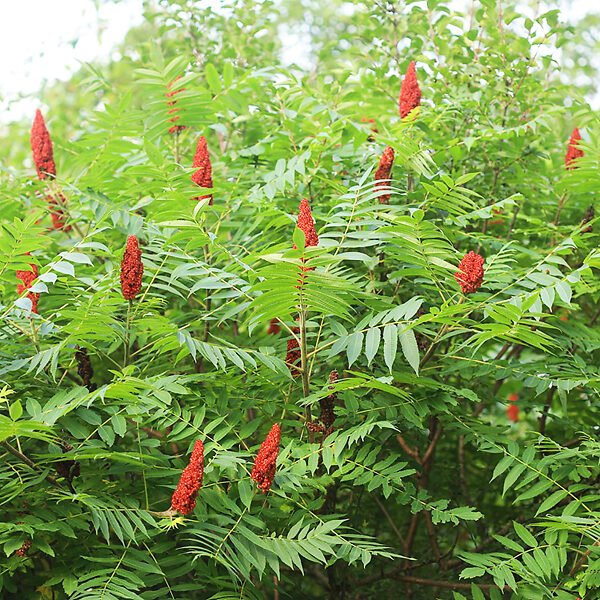
Here’s a concise information chart about Sumac:
| Aspect | Information |
|---|---|
| Botanical Name | Rhus spp. (several species) |
| Common Name | Sumac |
| Plant Type | Deciduous shrub or small tree |
| Zones | Varies by species, typically zones 3-9 |
| Sun Exposure | Full sun to partial shade |
| Soil Type | Well-drained soil, tolerant of poor soils |
| Watering | Moderate; drought-tolerant once established |
| Growth Habit | Upright to spreading |
| Height/Spread | Varies widely by species, typically 6-20 feet tall |
| Special Features | Red fruit clusters (drupes), vibrant fall foliage |
Sumac trees are small, often multi-stemmed species known for their brilliant fall colors and distinctive fruit clusters. There are several species of sumac native to different parts of the world.
Key characteristics of sumacs:
- Fast-growing and spread through root suckers
- Excellent for erosion control on slopes
- Important food source for wildlife
- Some species used in traditional cuisine and medicine
Sumacs are hardy plants that can thrive in poor soils and dry conditions. They’re often used in naturalized areas and wildlife gardens, but their spreading habit can make them too aggressive for formal landscapes. For more information on sumacs, visit the University of Wisconsin-Madison Arboretum.
From the towering sequoias to the delicate serviceberries, trees that start with S offer a remarkable diversity of forms, functions, and features. Whether you’re a gardener looking for the perfect ornamental tree, a conservationist interested in native species or simply a nature enthusiast eager to learn more about the world of trees, this list provides a comprehensive overview of these fascinating plants.
Remember, trees play crucial roles in our ecosystems and communities. They provide habitat for wildlife, help mitigate climate change by sequestering carbon, reduce air pollution, and enhance our urban and rural landscapes. By understanding and appreciating these trees, we can better protect and nurture them for future generations.
As you explore the world of S-trees, consider how you might incorporate some of these species into your own environment. Whether it’s planting a sugar maple for its glorious fall colors, choosing a swamp white oak for a wet area in your yard or simply admiring a majestic sequoia in a national park, these trees offer countless opportunities for connection with nature.
Let this guide be your starting point for a deeper exploration of the incredible diversity and beauty of trees. Each species has its own story to tell and its own unique contributions to make to our world. By learning about and caring for these trees, we can play a part in ensuring a greener, healthier future for all.







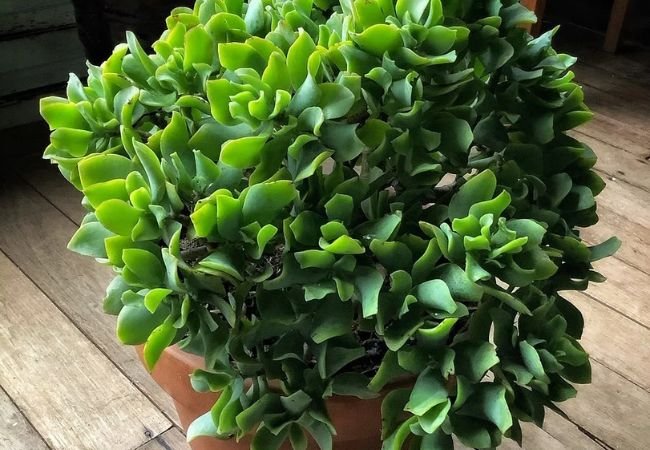
Leave a Reply